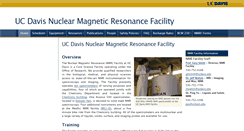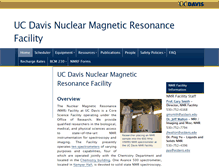UC Davis Nuclear Magnetic Resonance Facility UC Davis Nuclear Magnetic Resonance Facility
OVERVIEW
NMR.UCDAVIS.EDU TRAFFIC
Date Range
Date Range
Date Range
LINKS TO WEBSITE
How to Apply for the Ph. How To Apply for the M. MS in Pharmaceutical Chemistry Degree Requirements. Department welcomes FIVE faculty new hires this year! Letter to the Editor, Sacramento Bee, from Prof. Prof Osterloh Receives ACS Energy and Fuels Division Glenn Award. Prof Justin Siegel Leads His Undergraduate Research Team to Win iGEM Competition.
Tjeerdema Aquatic Toxicology AND ENVIRONMENTAL CHEMISTRY Lab. The mission of the Tjeerdema Research Group is to produce new information on the environmental fate and toxic actions of pesticides, petroleum hydrocarbons, oil dispersants and natural toxins in marine and freshwater systems and organisms. The dissipation of pesticides in flooded rice field conditions via volatilization, soil sorption, photodegradation and microbial degradation.
Electronic Behavior at High Pressure. Glassy Behavior in Iron Superconductors. Nuclear Magnetic Resonance and Correlated Electrons. And play a role in all realms of science, from the behavior of animals and people, to the quantum mechanical realm of the electron. In some cases electrons in condensed matter exhibit behavior typical of individual particles, but they can also do unexpected and surprising things.
WHAT DOES NMR.UCDAVIS.EDU LOOK LIKE?



NMR.UCDAVIS.EDU SERVER
WEBSITE ICON

SERVER SOFTWARE AND ENCODING
We revealed that this domain is employing the Apache/2.2.15 (Oracle) server.SITE TITLE
UC Davis Nuclear Magnetic Resonance Facility UC Davis Nuclear Magnetic Resonance FacilityDESCRIPTION
UC Davis Nuclear Magnetic Resonance FacilityPARSED CONTENT
The web site nmr.ucdavis.edu has the following on the site, "UC Davis Nuclear Magnetic Resonance Facility." I noticed that the webpage also said " 500 MHz Avance Solids NMR." They also said " 400 MHz Bruker Nanobay AVIIIHD. Secondary navigation and site ownership. UC Davis Nuclear Magnetic Resonance Facility. Researcher placing an NMR sample into the 600 MHz VNMRS NMR spectrometer at the UC Davis NMR Facility. One Avance 500 spectrometer, located in Kemper Hall. To the campus to enable users with long term research."ANALYZE SIMILAR WEB SITES
The NMR facility brings together an interdisciplinary group of researchers comprising of faculty from Chemistry, Biochemistry and Biology. Presently the Department of Chemistry and Biochemistry NMR facility manages three high resolution NMR spectrometers. A Bruker Avance III HD 800. MHz spectrometer equipped with a TCI cryoprobe. MHz spectrometer equipped with a triple resonances cryoprobe. And a recently upgraded Bruker Avance III HD 500. Welcome to the NMR Facility at UC Santa Cruz.
How to Use Booking System. The MREII 2013 grant will be used to purchase a new EPR console and microwave bridge, and the MREII 2014 grant will fund an ATMA-equipped TBI probe and BCU2 unit for the 500 MHz spectrometer. Basement Level, Room B41.
Bruker Avance III-HD 500 NMR. The facility is home to five superconducting magnets equipped for walk-up solution state analysis of 1. F as well as advanced techniques. Multinuclear cyroprobes permit the high sensitivity study of virtually any magnetic nucleus, including 2. Instruments in the facility are available to all qualified academic, research, or commercial users. Map to CAMCOR NMR Facility.
The Center for Biomolecular NMR Spectroscopy offers state-of-the-art high field NMR instrumentation for structural studies of biological macromolecules. The instrumentation presently available includes four-channel Bruker Avance 500, 600, and 700 MHz NMR spectrometers. The facility also has available an ultrahigh sensitivity 5mm.